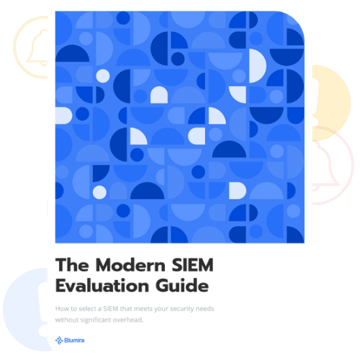SIEMs have been around for a few decades now – have you considered updating or replacing your traditional one with the automated capabilities of a modern SIEM?
In the same way that (some) threats continue to evolve, your security technology needs to keep up in order to effectively detect threats, enable you to respond quickly, and do it all with less overhead and total cost of ownership (TCO).
What are SIEMs? Why Use a SIEM?
At a high level, a Security Information and Event Management (SIEM) platform is intended to provide real-time analysis of security alerts generated by different systems in an organization’s environment. This is to help organizations detect and respond to potentially malicious activity.
Logs (an audit trail of historical security events) are generated by operating systems, appliances, devices, other security tools, etc. But in the event of a compromise, logs stored on their host systems can leave them exposed – meaning they can be potentially altered or deleted by attackers. That makes a breach or threat investigation very difficult, if not impossible, for organizations.
To solve this problem, SIEMs provide a way to collect, aggregate and centralize all logs in a secure, separate location. As a result, logs remain intact in the event of a compromise or hardware failure. This helps organizations track and monitor for activity indicative of threats like ransomware, brute-force attacks, lateral movement (when an attacker jumps from one system to another seeking access to sensitive data), and many others.
Why do SIEM Projects Fail?
Getting actionable alerts, insights and the full security benefits of a SIEM can be challenging for a number of reasons.
Cutting Through the Security Alert Noise
For a SIEM to provide real security value, you need to be able to configure it with fine-tuned rules and correlation with threat intelligence feeds to provide actionable alerts, not just more noise. Security and IT teams are inundated with alerts on a daily basis, and many of them are false-positives – that is, an alert that incorrectly indicates there’s a threat when there actually isn’t one. As a result, many teams tend to ignore these types of alerts as a way of dealing with alert fatigue. And that’s when critical alerts get missed, and your organization gets compromised.
Taking Action to Contain a Threat
Once an alert is sounded, SIEMs require a security team of experts to first understand the alert, then take appropriate action to either initiate further investigation or stop/contain the threat. Traditional SIEMs require a fully staffed, 24/7 security team to provide that level of human analysis, response and remediation – which, for smaller organizations, is not an option due to budget and security talent constraints. If you can’t take action on an alert, the security value of a SIEM cannot be realized.
Limited SIEM Integrations
As more organizations migrate infrastructure and workloads to the cloud, the complexity of hybrid (both cloud and on-premises) environments can make security visibility more challenging. Managing vendor sprawl is a real challenge. In a survey of security decision makers, 71% of respondents said they were adding security technologies faster than they were adding the capacity to proactively use them (ReliaQuest). If your existing and new technology investments can’t be integrated with your detection and response platform, then you may end up with serious security blindspots.
Why Switch to a Modern SIEM?
To get the most out of your SIEM, choose a modern integrated security platform that can reduce the noise, surface and prioritize real findings, and automate detection and response.
Consolidate Your Security Spend
In times like these, you might be rethinking your security spend these days as you pare down to only the essentials. A more modern SIEM should be able to do the heavy lifting of many solutions in one platform, while integrating with your full stack. It should enable you to detect threats in near real-time, then quickly analyze and provide guided steps for threat containment – all without requiring a fully staffed, 24/7 security operations team.
Get More Actionable Alerts
A fine-tuned SIEM can prioritize which alerts to send your team. A modern SIEM can correlate findings with multiple risk intelligence feeds to pinpoint new and evolving threats. Finally, it should automate security analysis and investigation, and in some cases, block threats through orchestration with your security stack.
Secure Your Journey to the Cloud
SIEM platforms must integrate across multi-vendor third-party tools like firewalls, identity providers, endpoint protection and more to aggregate, analyze and pull meaningful security insights. And as more organizations move to a remote work model supported by cloud infrastructure, a modern SIEM should be able centralize cloud data to quickly detect and remediate potential attacker activity, like lateral movement or privilege escalations.
Modern SIEMs: SOAR & SOC in One Platform
Security has come a long way to address many of the challenges of a traditional SIEM over the past few decades. Now they act more like extended SIEMs by converging platforms and functionality from Security Orchestration, Automation and Response (SOAR) for faster threat detection and response.
Instead of layering on multiple, disparate solutions, a modern SIEM gives you the ability to work through an entire security event investigation – end to end – from detection to remediation, without additional overhead and management.
At Blumira, we’ve worked to reduce the overall complexity of traditional SIEMs while pairing it with security automation to help organizations of all sizes detect and respond to security threats, including both insider and external.

 Advanced Threat Detection
Advanced Threat Detection
Blumira’s modern security platform is designed to cut through the noise of false-positives. We’ve automated threat detection with fine-tuned rules to reduce alert fatigue for your IT teams. Blumira taps into risk intelligence feeds to better detect new threats as they evolve. Our dashboards surface the most important findings while helping you meet compliance reporting requirements.
 Automated Threat Response
Automated Threat Response
When it comes to threat response – a modern SIEM can work in near real-time to stop threats through integrated features like dynamic block-lists delivered through your firewalls. And you can leave the security expertise to us – our security analysts provide step-by-step playbook guidelines to walk you through threat remediation.
 Ease of Deployment
Ease of Deployment
Our cloud-delivered platform can be deployed and managed by teams of any size so you can realize security value in just a matter of hours and days. Get the capabilities of a Security Operations Center (SOC) team without the overhead.
Learn more about Blumira’s modern SIEM platform, a legacy SIEM replacement.
Resources: More on Modern SIEMs
If you’d like to learn more about replacing your SIEM for a modern one, read “How Much is Your SIEM Solution Costing You?” to estimate the total cost of ownership of your current solution. Check out a few other additional resources:
The Modern SIEM Evaluation Guide
Get a comprehensive list of criteria to help you select a SIEM that meets your security needs, without significant overhead. In this guide, you’ll learn:
- Common challenges with the traditional SIEM approach
- What to expect from a SIEM platform and why it is crucial to your organization’s security strategy
- Key considerations for evaluating a modern SIEM solution
Webinar: Better Identity and Access Monitoring With Duo Security and Blumira
In response to the increase in remote work and widened attack surface, Duo Security and Blumira have partnered to deliver simplified multi-factor authentication (MFA), security logging, monitoring and threat detection.
Download our joint webinar to learn more and get your questions answered by Nikhil Khare, Product Manager of Applications Integrations at Duo Security, and Blumira’s VP of Operations Patrick Garrity.
Thu Pham
Thu has over 15 years of experience in the information security and technology industries. Prior to joining Blumira, she held both content and product marketing roles at Duo Security, leading go-to-market (GTM) and messaging for the portfolio solution Cisco Zero Trust. She holds a bachelor of science degree in...
More from the blog
View All Posts
Seeking a SIEM Alternative? Choose Automation
Read More
Guide: How to Replace Your SIEM
Read More
SIEM vs XDR vs SOAR vs SOC vs EDR vs MDR
Read MoreSubscribe to email updates
Stay up-to-date on what's happening at this blog and get additional content about the benefits of subscribing.

